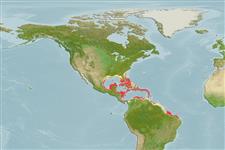>
Eupercaria/misc (Various families in series Eupercaria) >
Labridae (Wrasses) > Corinae
Etymology: Halichoeres: Greek, als, alis = salt + Greek, choiros = pig (Ref. 45335).
More on author: Valenciennes.
Environment: milieu / climate zone / depth range / distribution range
Écologie
marin récifal; profondeur 2 - 80 m (Ref. 9710), usually 4 - 60 m (Ref. 27115). Tropical; 23°C - 27°C (Ref. 27115); 35°N - 7°S, 99°W - 36°W
Western Atlantic: Bermuda and southern Florida, USA to southeastern Brazil.
Taille / Poids / Âge
Maturity: Lm ? range ? - ? cm
Max length : 19.3 cm TL mâle / non sexé; (Ref. 9626)
Épines dorsales (Total) : 9; Rayons mous dorsaux (Total) : 11; Épines anales: 3; Rayons mous anaux: 12. Juveniles yellow with silvery blue stripe along side. Super males (terminal males), have black vertical bar behind tip of pectoral fin, merging with broad black area on upper side, continuing to top of caudal peduncle and upper caudal fin. One of the easiest wrasses to identify at all its stages (Ref. 26938).
Commonly found on shallow and deep reefs and exposed rocky ledges. Feeds on various invertebrates. Forms leks during breeding (Ref. 55367). A protogynous hermaphrodite (Ref. 55367). Constantly on the move but easily attracted by divers. Generally of no interest to fisheries because of its small average size (Ref. 5217).
Life cycle and mating behavior
Maturities | Reproduction | Spawnings | Egg(s) | Fecundities | Larves
Distinct pairing during breeding (Ref. 205). Monandric species (Ref. 55367). Length at sex change = 7.3 cm TL (Ref. 55367).
Robins, C.R. and G.C. Ray, 1986. A field guide to Atlantic coast fishes of North America. Houghton Mifflin Company, Boston, U.S.A. 354 p. (Ref. 7251)
Statut dans la liste rouge de l'IUCN (Ref. 130435)
Menace pour l'homme
Harmless
Utilisations par l'homme
Pêcheries: commercial; Aquarium: Commercial
Outils
Articles particuliers
Télécharger en XML
Sources Internet
Estimates based on models
Preferred temperature (Ref.
123201): 24.2 - 28, mean 27 °C (based on 394 cells).
Phylogenetic diversity index (Ref.
82804): PD
50 = 0.5000 [Uniqueness, from 0.5 = low to 2.0 = high].
Bayesian length-weight: a=0.00977 (0.00574 - 0.01664), b=3.15 (3.00 - 3.30), in cm total length, based on LWR estimates for this species & Genus-body shape (Ref.
93245).
Niveau trophique (Ref.
69278): 3.7 ±0.2 se; based on diet studies.
Résilience (Ref.
120179): Milieu, temps minimum de doublement de population : 1,4 à 4,4 années (Preliminary K or Fecundity.).
Fishing Vulnerability (Ref.
59153): Low vulnerability (10 of 100).
Nutrients (Ref.
124155): Calcium = 67 [41, 115] mg/100g; Iron = 0.656 [0.387, 1.181] mg/100g; Protein = 18.5 [15.7, 20.7] %; Omega3 = 0.171 [0.112, 0.263] g/100g; Selenium = 29.4 [17.9, 50.9] μg/100g; VitaminA = 136 [42, 509] μg/100g; Zinc = 1.47 [1.02, 2.26] mg/100g (wet weight);
